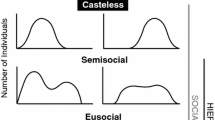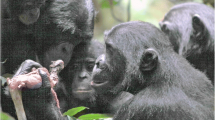Abstract
People have always been social. Ethnographic evidence suggests that transfers of food and labor are common among contemporary hunter-gatherers, and they probably were common in Paleolithic groups. Archaeological evidence suggests that cooperative breeding went up as we settled down: as territory defenders became more successful breeders, their helpers’ fertility would have been delayed or depressed. And written evidence from the Neolithic suggests that the first civilizations were often eusocial; emperors fathered hundreds of children, who were provided for and protected by workers in sterile castes. Papers in this issue of Human Nature look at helpers and workers across the eusociality continuum—from hardworking grandmothers and grandfathers, to celibate sisters and brothers, to castrated civil servants—from the first foragers to the first states.
Similar content being viewed by others
References
Alvarez, H. P. (2000). The grandmother hypothesis and primate life histories. American Journal of Physical Anthropology, 113, 435–50.
Austin, C., et al. (2013). Barium distributions in teeth reveal early-life dietary transitions in primates. Nature, 498, 216–219.
Barham, L., & Mitchell, P. (2008). The first Africans. Cambridge: Cambridge University Press.
Bar-Yosef, O. (2002). The upper Paleolithic revolution. Annual Review of Anthropology, 31, 363–93.
Batra, S. (1966). Nests and social behavior of halictine bees of India. Indian Journal of Entomology, 28, 375–93.
Betzig, L. (2012). Means, variances and ranges in reproductive success: comparative evidence. Human Behavior and Evolution, 33, 309–17.
Betzig, L. (2013). Darwin’s question: How can sterility evolve? In K. Summers & B. J. Crespi (Eds.), Human social evolution: The foundational works of Richard Alexander (pp. 365–374). Oxford: Oxford University Press.
Betzig, L. (2014). Eusociality in history. Human Nature, 25(1), in press. doi:10.1007/s12110-013-9186-8.
Borgerhoff Mulder, M., et al. (2009). Intergenerational wealth transmission and the dynamics of inequality in small-scale societies. Science, 326, 682–88.
Brown, J. L. (1987). Helping and communal breeding in birds. Princeton: Princeton University Press.
Childe, V. G. (1936). Man makes himself. London: Watts & Co.
Crespi, B. (2005). Social sophistry: logos and mythos in the forms of cooperation. Annales Zoologici Fennici, 42, 569–71.
Crespi, B. (2014). The insectan apes. Human Nature, 25(1), in press. doi:10.1007/s12110-013-9185-9.
Emlen, S. T. (1982). The evolution of helping, I, II: an ecological constraints model. American Naturalist, 119, 29–53.
Emlen, S. T. (1995). An evolutionary theory of the family. Proceedings of the National Academy of Sciences USA, 92, 8092–99.
Foster, K., & Ratneiks, F. (2005). A new eusocial vertebrate? Trends in Ecology and Evolution, 20, 363–64.
Gurven, M., & Kaplan, H. (2007). Longevity among hunter-gatherers: a cross-cultural examination. Population and Development Review, 33, 321–65.
Halpern, B. (1988). The first historians: The Hebrew Bible and history. San Francisco: Harper & Row.
Hawkes, K. (2014). Primate sociality to human cooperation: why us and not them? Human Nature, 25(1), in press. doi:10.1007/s12110-013-9184-x.
Hawkes, K., et al. (1998). Grandmothering, menopause, and the evolution of human life histories. Proceedings of the National Academy of Sciences USA, 95, 1336–39.
Hill, K., et al. (2011). Co-residence patterns in hunter-gatherer societies show unique human social structure. Science, 331, 1286–89.
Hölldobler, B., & Wilson, E. O. (2009). Superorganism. New York: Norton.
Hrdy, S. B. (2009). Mothers and others. Cambridge: Harvard University Press.
Ji, T., Xu, J.-J., Mace, R. (2014). Intergenerational and sibling conflict under patrilocality: a model of reproductive skew applied to kinship. Human Nature, 25(1), in press. doi:10.1007/s12110-013-9188-6.
Kaplan, H., Hill, K., Lancaster, J. B., & Hurtado, A. M. (2000). A theory of human life history evolution: diet, intelligence, and longevity. Evolutionary Anthropology, 9, 156–85.
Kaplan, H., Gurven, M., Winking, J., Hooper, P. L., & Stieglitz, J. (2010). Learning, menopause, and the human adaptive complex. Annals of the New York Academy of Sciences, 1204, 30–42.
Keeley, L. (1988). Hunter-gatherer economic complexity and “population pressure”: a cross-cultural analysis. Journal of Anthropological Archaeology, 7, 373–411.
Keen, I. (2006). Constraints on the development of enduring inequalities in Late Holocene Australia. Current Anthropology, 47, 7–19.
Kelly, R. (2013). The foraging spectrum (2nd ed.). New York: Cambridge University Press.
Kim, P. S., Coxworth, J. E., & Hawkes, K. (2012). Increased longevity evolves from grandmothering. Proceedings of the Royal Society B, 279, 4880–84.
Kramer, K. L. (2010). Cooperative breeding and its significance to the demographic success of humans. Annual Review of Anthropology, 39, 417–36.
Kramer, K. L. (2011). The evolution of human parental care and recruitment of juvenile help. Trends in Ecology and Evolution, 26, 533–40.
Kramer, K. L. (2014). Why what juveniles do matters in the evolution of cooperative breeding. Human Nature, 25(1), in press. doi:10.1007/s12110-013-9189-5.
Langergraber, K. E., et al. (2012). Generation times in wild chimpanzees and gorillas suggest earlier divergence times in great ape and human evolution. Proceedings of the National Academy of Sciences USA, 109, 15716–21.
Lee, R. B. (1979). The !Kung San. Cambridge: Cambridge University Press.
Lee, P. C. (2012). Growth and investment in hominin life history evolution: patterns, processes, and outcomes. International Journal of Primatology, 33, 1309–1331.
McBrearty, S., & Brooks, A. S. (2000). The revolution that wasn’t: a new interpretation of the origin of modern human behavior. Journal of Human Evolution, 39, 453–563.
Mellars, C., Boyle, K., Bar-Yosef, O., & Stringer, C. (2007). Rethinking the human revolution. Cambridge: McDonald Institute for Archaeological Research.
Schmandt-Besserat, D. (1996). How writing came about. Austin: University of Texas Press.
Sear, R., & Mace, R. (2008). Who keeps children alive? A review of the effects of kin on child survival. Evolution and Human Behavior, 29, 1–18.
Sherman, P. W., Lacey, E., Reeve, K., & Keller, L. (1995). The eusociality continuum. Behavioral Ecology, 6, 102–108.
Skutch, A. F. (1935). Helpers at the nest. Auk, 52, 257–273.
Smith, T. M. (2013). Teeth and human life history evolution. Annual Review of Anthropology, 42, in press.
Strassmann, B., & Garrard, W. (2011). Alternatives to the grandmother hypothesis. Human Nature, 22, 201–22.
Thompson, M. E., et al. (2007). Aging and fertility patterns in wild chimpanzees provide insights into the evolution of menopause. Current Biology, 17, 2150–56.
Tuljapurkar, S. D., Puleston, C. O., & Gurven, M. D. (2007). Why men matter: mating patterns drive evolution of human lifespan. PLoS One, 2(8), e785.
Turke, P. W. (1988). Helpers at the nest: Childcare networks on Ifaluk. In L. Betzig, M. Borgerhoff Mulder, & P. Turke (Eds.), Human reproductive behaviour: A Darwinian perspective (pp. 173–88). Cambridge: Cambridge University Press.
Vehrencamp, S. (1983). A model for the evolution of despotic versus egalitarian societies. Animal Behaviour, 31, 667–682.
Wilson, E. O. (1971). The insect societies. Cambridge: Harvard University Press.
Wilson, E. O. (1975). Sociobiology: The new synthesis. Cambridge: Harvard University Press.
Acknowledgments
Thanks to Karen Kramer for intelligent comments, and to all contributors for important papers on an important subject. I am forever indebted to Jane Lancaster for making this special issue possible, and to Sarah Blaffer Hrdy for encouragement throughout.
Author information
Authors and Affiliations
Corresponding author
Rights and permissions
About this article
Cite this article
Betzig, L. Eusociality: From the First Foragers to the First States. Hum Nat 25, 1–5 (2014). https://doi.org/10.1007/s12110-013-9187-7
Published:
Issue Date:
DOI: https://doi.org/10.1007/s12110-013-9187-7




